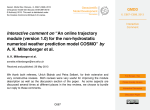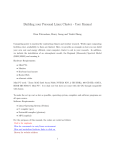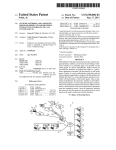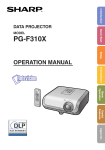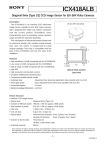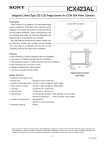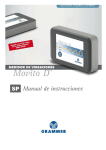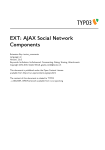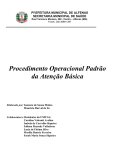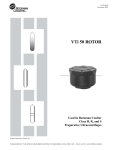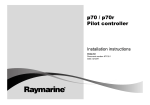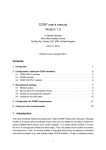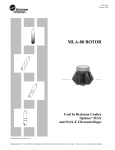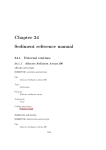Download Printer-friendly Version
Transcript
Instrumentation Methods and Data Systems Open Access Open Access Instrumentation Methods and Data Systems Discussions Geoscientific Model Development Discussions Open Access Open Access Hydrology and Earth System Sciences Open Access Hydrology and Earth System Sciences Open Access Geosci. Model Dev. Discuss., 6, C667–C698, 2013 Geoscientific www.geosci-model-dev-discuss.net/6/C667/2013/ © Author(s) 2013. This work is distributed under Model Development the Creative Commons Attribute 3.0 License. Discussions Discussions Discussions Open Access The Cryosphere Open Access The Cryosphere Received and published: 29 May 2013 Open Access [email protected] Open Access A. K. Miltenberger et al. Discussions Open Access Open Access Interactive comment on “An online trajectory Ocean Science Ocean Science module (version 1.0) for the non-hydrostatic numerical weather prediction model COSMO” by A. K. Miltenberger et al. Solid Earth Solid Earth We thank both referees, Ulrich Blahak and Petra Seibert, for their extensive and very constructive reviews. Both reviews were very useful for improving the module description as well as the discussion section of the paper. As some aspects are discussed several times at different places in the two reviews, we choose to bundle our reply to these comments. C667 1. Neglect of diffusive processes / Lagrangian parcel vs. Lagrangian particle models Both referees allude to the aspect that our model does not consider subgrid scale (turbulent) processes for the calculation of the trajectories: Ulrich Blahak C197/C198: The authors strongly advocate the Lagrangian perspective also for very high resolution applications. However, diffusive processes are completely neglected in the new module. Therefore it is questionable and will depend on the application, if there is really a big gain in “physical” accuracy, if nontheless trajectories are interpreted as coherent air parcels over several days. Therefore, what I miss is a more thorough discussion of the influence of diffusive processes. Results of this module might be misleading for, e.g., applications in high resolution dispersion modeling. What is the advantage of doing online trajectories when one could use artificial tracers in the model to simulate advection and diffusion simultaneously? Ulrich Blahak C198: While this may justify publication in GMD, the comparatively simple numerical implementation (e.g., no turbulent fluctuations on the trajectories) could have some implications for some applications like dispersion modeling or analysis of strongly turbulent flows in convective clouds. This fact should be elaborated more in the paper. Ulrich Blahak C199: Consequences of the neglect of diffusive processes - As mentioned above, please add in section 1 and/or in section 4 (at places where you think it is appropriate) short discussions on the influence of turbulent diffusive processes and the consequences, if these are neglected and if the trajectories are interpreted as coherent air parcels over long times. Discuss which kind of applications, at which spatial/temporal scales, potentially could suffer from this neglect and to what extent. One example of a paper applying an autoregressive Markov process to represent turbulent fluctuations on trajectories for high-resolution Monte Carlo dispersion modeling would be Gross, H. Vogel, F. Wippermann, 1987: Dispersion over and around a C668 steep obstacle for varying thermal stratification – numerical simulations, Atmospheric Environment, Volume 21, Pages 483-490. Petra Seibert C 358: Another reviewer has questioned the value of mean-wind trajectories at the spatial scale covered by the model. Also the authors allude to this issue in their discussion of the behaviour near ground. My opinion is that a trajectory model (this is the term that I am using for a mean-wind-based model, as opposed to a Lagrangian particle model which would simulate also the effects of subgrid-scale motions) does have its place also at high resolution (even at LES scale) as it allows to investigate atmospheric motion patterns represented explicitly in the model in a way that cannot be achieved e.g. by a Eulerian tracer carried (unless a number of tracer species is used which is the same as the number of trajectories, but even then diffusive properties of the numerical integration would deteriorate the result). However, I think the authors could invest some additional work to include a survey of possible application types, the set-ups related to them, and their merits and shortcomings. This would be a significant benefit for users beyond their own group and enhance the value of the paper. It is true that our trajectory model does not consider diffusive processes, but this is also not the goal of our study. For applications like dispersion modeling there are other (better) tools and methods like Lagrangian particle dispersion models and passive tracer models, which aim to represent subgrid-scale processes. In the following we refer to trajectory models neglecting diffusive processes as Lagrangian parcel models, while those representing subgrid-scale velocity variations are named Lagrangian particle (dispersion) models (LPDMs). The two approaches - Lagrangian parcel and particle dispersion models - have different strengths and weaknesses and are therefore suitable to investigate different scientific questions. Therefore we agree with the second referee, Petra Seibert, that the Lagrangian parcel model approach has its validity also for high-resolution modeling and even LES. C669 The Lagrangian parcel model represents the average properties of an air parcel with a typical volume of a grid cell. The motion of such an air parcel represent the mean of a particle plume starting within a grid box in a Lagrangian particle model. As noted for instance by Stevens et al. (1996) and utilized in trajectory-based moisture source diagnostics (Sodemann et al. 2008), the time average result of mixing is represented on the scale of gridboxes along parcel trajectories. Therefore on temporal scales that are in agreement with the gridspacing and the advection velocity, the variation in a finite size box is well captured by the parcel model. If subgrid scale variations and according timescales are the focus of the study, then of course Lagrangian particle dispersion models are the tool of choice. Note that then a much larger number of particles must be calculated (compared to the number of parcels with our approach) in order to statistically sample the subgrid-scale variations. For instance, as illustrated in the Stevens et al. (1996) study on timescales in non-precipitating stratocumulus clouds, a microphysical boxmodel driven with a Lagrangian parcel model may have problems at cloud edges as warming and drying rates of individual parcels may be too strong due to the neglect of subgrid-scale variations in humidity and temperature. Nevertheless parcel models are successfully used in the literature for Lagrangian analyses of LES simulations (e.g., Yeo and Romps, 2013). In contrast to LPDM they allow to study the influence of non-resolved mixing be it from parameterizations or numerical diffusion on the mean properties of air parcels. In addition, as Yeo and Romps (2013) pointed out, air parcel trajectories ensure a constant mass of dry air associated with the trajectory, while this is not the case if subgrid-scale velocities are additionally taken into account. In addition it is important to keep in mind that the represented processes using mean-wind trajectories strongly depend on the grid-spacing and hence is different from LES to NWP applications: While it may be inappropriate (or impossible) to study deep convection with a Lagrangian parcel model in a NWP model that does not resolve convective processes, it is justified in convection resolving models. Lagrangian particle models have been specifically developed to investigate the C670 dispersion of pollutants in the turbulent boundary layer, where subgrid-scale velocity variations are particularly important. Outside of the planetary boundary layer turbulence becomes less important and therefore the solution of Lagrangian particle models and Lagrangian parcel models should converge. Online trajectories aim to represent the motion of air parcels as accurately as possible, according to the resolved scale wind field. Thereby the air parcels are not regarded as “closed boxes”, but as permeable for subgrid-scale motions, which they do not aim to represent explicitely. If the latter is the objective of a study, then Lagrangian particle models must be used. The differentiation between sub-grid scale processes and the resolved wind is fundamental, although it relates to different scales and processes for different model resolutions. We acknowledge that it is important to discuss the difference between the two approaches in the paper together with their advantages and disadvantages for certain scientific questions. As suggested we will add a note in the introduction and an additional paragraph on this issue in the discussion section. 2. Representativity of literature in the introduction section Ulrich Blahak C196/197: All in all, the authors reference an adequate quantity of literature concerning applications in synoptic meteorology, which is their field of expertise. There are less citations of the more technical aspects of trajectory calculations, as well as of applications in other fields like lagrangian dispersion modeling. For the scope of this paper, this should however be fine. Petra Seibert C359: The list of possible applications of Lagrangian, trajectory-based analyses is obviously only meant to give some illustrations, but in the light of my remarks above on applicability of this specific high-resolution trajectory model, they may want to give more consideration specifically to high-resolution applications. We will include a few more references on high-resolution applications. Specifically we C671 want to include the following studies in the introduction as examples how trajectories have been successfully used in high-resolution models: a) Lagrangian parcel model applications in high-resolution NWP models • Stern et al. (2013) investigated the motion of parcels inside the eye of an idealized hurricane by calculating trajectories based on one to six minute NWP output. • Wang and Xue (2012): trajectories based on one-minute NWP output were employed to determine the origin of air parcels feeding initial convective cells. The study investigates convective initiation cases associated with a cold front dryline system from the IHOP field project. • Fierro et al. (2009): In idealized simulations of a nocturnal equatorial oceanic squall line (online) trajectories are used to investigate the hot tower hypothesis. The study concludes based on the evolution of equivalent potential temperature and latent heating along the trajectories that most parcels experience mixing at low-levels and that the associated loss of buoyancy is compensated by latent heat release from ice processes. b) Lagrangian parcel model applications with LES • Yamaguchi and Randall (2012): This study of cloud-top entrainment in marine stratocumulus boundary layer clouds employs a Lagrangian parcel-tracking model online in a LES. Though for this model a parameterization of sub-gridscale velocities is available it is not used in the study, as the authors found it to have negligible effect on the trajectories. • Stevens et al. (1996): In this study of non-precipitating stratocumulus clouds trajectory ensembles calculated with LES resolved winds were used as driving C672 conditions for a microphysical parcel model. Besides the illustration of the usefulness of the approach to investigate critical timescales for droplet growth, the paper provides a discussion of the representation of entrainment and its effect on microphysical modeling. • Kogan (2006): This study used the approach of Stevens et al. (1996) for drizzling stratocumulus clouds. The in-cloud residence time is found to be 2-5 times longer than for non-drizzling stratocumulus indicating that cycling of air parcels inside the cloud is important for drizzle formation. • Yeo and Romps (2013) computed trajectories with the resolved wind to study entrainment rates and residence times in convective clouds. c) Lagrangian Particle Dispersion models • Bellasio et al. (2012) described a long-range Lagrangian particle dispersion model developed for simulating radioactive clouds. The paper comprises a comparison to the ETEX tracer release experiment. • Weil et al. (2012) coupled an LPDM to a LES for investigation of plume dispersion in a convective planetary boundary layer. • Gross et al. (1987): Description of the simulation of pollutant dispersion from a point source around a steep obstacle. Petra Seibert C361: Page 1229: I am wondering whether there are no more recent applications of LAGRANTO than 2005. Of course there are numerous more recent applications of LAGRANTO, but the list was meant to indicate the spectrum of applications for which it has been used. But of course we can in addition name a few more recent papers, as for instance Lefohn et C673 al. (2011), Cirisan et al. (2013), Schemm et al. (2013), and Grams et al. (2013). 3. Terrain intersecting trajectories Ulrich Blahak C198: The authors honestly highlight one remaining technical problem of their new online trajectory module, namely that too many trajectories intersect the ground, especially in mountaneous regions. Currently this problem is mitigated by the standard method of simply reinitializing ground-hitting trajectories 10 m above the ground. However, the deeper reasons for this behaviour are not very well explained, and this should be improved in the manuscript. This is important for future users of the module to decide whether this fact is acceptable for their application or not. Without beeing a detailed expert, I would presume that there can be found something in the literature on this topic. Ulrich Blahak C 203/204: Issue with too many trajectories hitting the ground, starting at p. 1242, line 9: Although I can follow your argument with linear interpolation smoothing the wind- field (presumably especially the vertical compontent) and beeing responsible for curving down your example trajectories in figure 6 towards the surface, the exact behaviour near the surface should depend on details of what is assumed for the windfield close to the surface and how this interplays with a possible violation of the vertical CFL criterion (see above, in this case with ∆z = vert. distance to the ground). However, I do not understand figure 6 because of missing information. What are the axis labels, what is the grid spacing of the Eulerian framework? 1000 X-units as suggested by the crosses on the orography line? What is the online timestep resp. the “typical” online travel distance during 1 timestep? What exactly is the windfield (you only mention in the figure caption, that it is linear. But at which value does it start at the surface? All this information is necessary to understand why the online trajectory can hit the ground. And I do not understand why it can continue below the surface. Should it not end on impact, i.e., when its position first falls below the orography during the C674 Petterssen scheme iteration? From this I conclude that the surface-normal wind compontent does not go to 0 towards the ground and that there is an artificial non-zero velocity below the surface, so that the iteration may continue there and eventually may converge to a final position above the surface. Is that true? If yes, how is this calculated? Constant extrapolation from the lowest model level? Petra Seibert C361: The ground intersection problem should not be introduced as the second-last paragraph of the whole paper! It belongs into the module description. We agree that it is probably not best to discuss the ground intersection problem in the discussion section. In the revised version we will include a section in the module description with an extended discussion of the problem. As promised below we will also include a description of the lower boundary condition and we will improve the description of our idealized example. However, we do not think that the lower boundary condition itself is causing the terrain intersection problem. In the meanwhile we did some further analysis to pin down the problem of ground intersecting trajectories: For all trajectories that hit the surface in the COSMO7 simulation of our case-study, the surface elevation as well as the height of the lowest model level are traced along the trajectories in the last 200 time-steps before ground intersection. In addition the surface elevation, that would be beneath the trajectory if it continued in the same direction and speed as during the last timesteps before the terrain intersection was computed for the next 200 time-steps. From this data a composite of the surface elevation, the lowest model level height and the trajectory height was derived by normalizing and averaging the data. This composite shows the average surface elevation 200 time-steps before the ground intersection and its extrapolated behavior for the 200 time-steps after the ground intersection (Fig. 1). The distance, that the trajectories travel during these about 400 time-steps corresponds to approximately 3 to 6 grid points. As this composite closely resembles our hypothetical example in the original paper, C675 it supports our original hypothesis that the majority of ground intersections occur due to errors introduced by spatial horizontal interpolation. Reducing the time-step of the trajectory integration so strongly, likely leads to a more frequent detection of terrain intersections and therefore leads to an increased percentage of terrain hitting trajectories. The hypothesis linking the ground intersection to the spatial interpolation, is also supported by our analysis of the vertical Courant number (Fig. 3). The vertical CFLcriterium is never exceeded in the COSMO2.2 and COSMO14 simulations and in the COSMO7 simulation only very rare exceedances are registered. Ulrich Blahak C204: On p. 1243, starting in line 5, some possibilities for mitigating this problem are shortly mentioned. Perhaps you could elaborate a little more on the possible changes to the integration scheme close to the surface, in addition to adding turbulent fluctuations. Could these be • Alternative starting value for the Petterssen iteration (see above)? • Sub-timestepping near the ground so as to keep the vertical CFL < 1 (see above), using suitable time interpolation of u? • Changes to the lower boundary condition(s)? We will include some discussion of such a modification of the integration scheme close to the surface. Petra Seibert C361: I am surprised that consideration of turbulence is offered as possible way to overcome the ground intersection problem. I don’t see why this should be effective. On the other hand, this would totally change the character of the model, and transform it from a trajectory model to a dispersion model. This would be a big step, in concept but also in terms of algorithm and code. Introducing turbulent diffusion in only a part of the boundary layer (if this is meant) would be quite unphysical. C676 After the further investigations we did, we agree that adding turbulence is not the solution to the problem. We will remove this point from our suggestion list. 4. Structure of module description Petra Seibert C358: However, the description of the module should be made more detailed and better structured. It would also be useful to better explain (and maybe explore) certain decisions and their consequences. Petra Seibert C359: Module description. I have the following suggestions for improving: • First, summarise the algorithms used in LAGRANTO, and clearly point out where additional details (if not included) can be found (is the Wernli and Davies paper fully comprehensive? If not, add other source, or add corresponding document as supplementary material). • Then, give an overview where the COSMO module deviates from the off-line version. • Finally, give the details on the COSMO-specific features. Unfortunately, though not fully comprehensive, the Wernli and Davies paper is the only and latest technical reference for LAGRANTO. However, we describe all essential algorithms used in the section “Physical Core“. There the numerical procedure to integrate the trajectory equation and the interpolation method are described. This section corresponds to the first section suggested by Petra Seibert. The COSMO module only deviates from the LAGRANTO algorithms in not using a temporal interpolation and in being parallelized (see section “Parallelization and Communication“). Both of these issues are discussed in the paper. There are little COSMO-specific features. The code developed for this project should be applicable C677 to any NWP model that has a spatial domain decomposition for the parallelization. Only the technical details of writing the output file (addressing of variables) as well as probably the input structure have to be slightly adapted. We will make this clearer in the revised paper. Petra Seibert C360: Section 2.3: I would call this “selection of trajectory starting points” instead of “initialisation”. The fact that back trajectories are not (easily) possible for on-line calculation needs to explained already in the introduction, and then be discussed in the Section on applications that I propose. I disagree with the statement that this limitation “slightly complicates” studies (page 1241 bottom) – it is a limitation! We will include this fact in the introduction. Of course it is a limitation that only forward trajectories can be calculated, but we think it is not really tremendously difficult to find a suitable starting region, if one is interested in trajectories ending at a certain location. 5. Issues related to details of the implementation Ulrich Blahak C199/200: Presentation of the Petterssen Scheme and its implementation in section 2.1 You present the Petterssen scheme in a way which is customary in the literature as a kind of predictor-corrector-method. I think your term “iterative forward Euler timestep” from page 1230, line 5, is wrong. However, in my view it would be more enlightening to present it slightly differently: To solve the trajectory equation ~x˙ = ~u(~x(t), t) numerically forward in time from time ti to ti+1 , a second order semi-implicit discretization in space and time is used, which reads ˙ ˙ ~x(ti+1 ) = ~x(ti ) + ∆t ~x(~x(ti ),ti )+~x2(~x(ti+1 ),ti+1 ) = ~x(ti ) + ∆t ~u(~x(ti ),ti )+~u2(~x(ti+1 ),ti+1 ) This is an implicit equation for ~x(ti+1 ), because the last differential on the right-hand side ~u(~x(ti+1 ), ti+1 ) depends itself on x(ti+1 ). A common method to solve such a problem numerically is a fixpoint iteration. The above equation is alread in fixpoint form, so all we need is a starting value ~x0 (ti+1 ) resp. ~u(~x0 (ti+1 ), ti+1 ). Then the n-th C678 iteration step is given by ~xn (ti+1 ) = ~x(ti ) + ∆t~u(~x(ti ), ti ) + ~u(~xn -1(ti+1 ), ti+1 ) 2 which equals your second through n-th equation on page 1230. The convergence properties of such an iteration depend on the properties of the flow field and the starting value. In your case, the starting value has been simply chosen as ~u(~x(ti ), ti ), so that your Eq. (1) is recovered. However, you would be basically free to choose different starting values. For example, near the ground, ~u(~x0 (ti+1 ), ti+1 ) = 0 could help to reduce the problem of terrain hitting trajectories during the first iteration step. We will change the naming of the numerical procedure. We thank the reviewer for offering an alternative description of the scheme, but since we regard our original presentation more intuitive, we decided not to change it. The result of both derivations is equivalent. Ulrich Blahak C200/201: Detailed specification of the lower boundary condition(s) I miss a detailed specification of the lower boundary condition(s) for computing the linear spatial interpolations of the velocity components near the ground. These are decisive for the behaviour of trajectories near the ground and should be clearly mentioned, so that future users may decide on the applicability of the module for their specific application. Add a paragraph in section 2.1 or an own subsection, whichever you feel Details of these lower boundary conditions could also be responsible for the problem of too many trajectories hitting the ground (see below). Which boundary conditions are assumed in other trajectory schemes from the literature? We extrapolate the horizontal wind velocity below the lowest model level with the same algorithm used to determine the lower boundary condition for the vertical velocity in the dynamical core of COSMO. Namely the velocity at some height z below the lowest model level is calculated by linear extrapolation of the difference between the two lowest model levels. We will add this information in section 2.1. Ulrich Blahak C199: Please specify somewhere here, that the COSMO-model uses a C679 staggered Arakawa C-grid and is formulated in terrain following and rotated spherical coordinates, because this is important for the spatial interpolation procedure and the portability of the module to other NWP or climate models. We will add a sentence in the description of the COSMO model including these details. In addition we add a paragraph on the portability of the module in section 2. Ulrich Blahak C199: At the end of this secion, you mention “the trace variables”, but this important part of the module is not explained further. Please add a short paragraph on this aspect and on its applications, starting perhaps on p. 1229, line 8. Paragraph will be added. Ulrich Blahak C204: Discussion on the properties of the new module and possible enhancements in the future - You mention that you apply tri-linear interpolation in space (p. 1230, line 23), and this is perfectly fine. I presume this means that the interpolation is done between the 8 neighbours of an interpolation point in a way that “horizontal” interpolations in i and j direction are performed along the terrain-following coordinates (which is both efficient and accurate). If such details would have been mentioned in the text, things would be more easy to understand. You could incorporate this into the required new description of the lower boundary conditions (see above). Yes, the interpolation is performed along the terrain-following coordinates. We will add this in the description of the interpolation procedure. Petra Seibert C360: Time step: In section 3.2 time step durations are stated. Are they specific to the case study? If not, move them up! How is the time step determined in COSMO? Are there different time steps for different processes? How do they relate to the trajectory time step? All this should be in Section 2. The time step for COSMO is specified by the user; it depends on the grid spacing used and on the application. In that sense the time step is specific for the case study, though the values used here are the standard ones used at MeteoSwiss for the respective C680 spatial resolution. For some subroutines the time step is split into smaller steps. For instance, this applies for the sedimentation of hydrometeors if the vertical CFL criterion is violated and for the fast wave solver. The trajectory time step is equal to the major time step of COSMO. We will state this more clearly in section 2.1. Petra Seibert C360: Missing technical information: I presume that all is implemented in Fortran90/95/2003/. . . , it would be useful to explicitly say this. Which implementation of the MPI library is used? Also say at the beginning and in the abstract that it is an MPI (distributed-memory machine) implementation. The implementation is done in Fortran 90 as the entire COSMO model code. We will state this in the introduction part of section 2. We use the implementation MPICH (http://www.mpich.org), which will be added to the last line of section 2.2. Petra Seibert C362: Section 3.2, last line: The “jump flag” needs to be explained (by the way, the wording is misleading, it is not so much a flag=indicator but rather an algorithmic feature.) The jump flag is already explained at the end of section 2.1. We refer to this feature of the algorithm as “jump flag“, because it can be switched on and off by switch in the namelist. In LAGRANTO it was an additional parameter in the call of the program and therefore a “flag“. 6. Numerical costs Petra Seibert C360: Section 2.2: It would be very helpful to have a better idea of the numerical costs of the trajectories before this discussion, but it comes only in Section 3. It is necessary to give at least some more information here. It is not clear immediately why the simple trajectory integration should contribute significantly to the computational resources compared to the integration of a comprehensive NWP model. C681 Petra Seibert C360: Section 3.3, discussion of performance. I don’t know whether it is justified to discuss the performance with a single case study. Please explain if and why. If not, more case studies need to be done (no need to discuss them in detail, just for quantifying performance). The relative runtime (or runtime increase) should be evaluated also as a function of the number of trajectories. This will be important for future users. As we performed only this one case study so far, it is hard to make a general statement on the computational costs of the online trajectory calculation. Because the performance depends strongly on the number of trajectories, the number of traced variables and also on the setup of the Eulerian part of the model, we shifted the discussion of performance to section 3. The numerical costs of the trajectory calculation do actually not result from the trajectory integration itself, as this is really comparatively simple compared to the integration of the NWP model, but has mainly three sources: • Writing of output files: COSMO has no asynchronous output so far and in addition all output is written by one processor. In case the trajectory position together with a potentially large number of trace variables is written to a file after every model time step this adds significantly to the runtime of the model. • Communication between the processors for trajectories passing between domains: This strongly depends on the distribution of trajectories across the entire computational domain. • (Excessive) interpolation of trace variables Of course we plan to do more case studies in the future, but we think it is not worth to compute other case studies only for assessing the performance of the module. This would also not be very useful because the performance depends on the architecture of the supercomputer and the number of other integrations running on the same C682 machine. As we cannot control these factors easily, the runtime increases given in the article are only thought as a rough estimate. In our case study the runtime increase seems to scale approximately linearly with the number of trajectories (taking only half of the trajectories reduces the runtime increase by approximately a factor two). Decreasing the number of traced variables by a factor two leads in our simulation to a reduction of the runtime increase by approximately a factor three. This indicates that the runtime increase on our machine is strongly determined by IO. 7. Numerical properties of the module - Convergence, CFL criterion etc. Ulrich Blahak C201: Convergence criterion for the Petterssen Scheme As described in section 2.1, your scheme uses a fixed number of iterations for the Petterssen Scheme: “The number of iterations required for convergence depends on the flow situation and the time step, but we find that a default value of three iterations gives mostly satisfactory results. However, it is possible to alter this number via the namelist”. Here, a convergence analysis of the fixpoint iteration would be helpful. We propose to introduce as an alternative a termination criterion into the iteration, so that the iteration stops if the trajectory increment |~xn (ti+1 )-~xn -1(ti+1 )| from one step to the next falls below a predefined threshold. Then do a histogram, after how many steps convergence was reached, and mention if some instances did not converge at all (i.e., iteration did not terminate after some maximum step number). Thank you for this suggestion. We performed the suggested analysis for the alpine flow casestudy: The iteration stopped either after 50 iterations or if ((|xn (ti+1 )-xn 1(ti+1 )| < 0.1dx)(|yn (ti+1 )-yn -1(ti+1 )| < 0.1dy)(|zn (ti+1 )-zn -1(ti+1 )| < 1m)). The probability distribution of the number of required iterations is shown in Fig. 2 for the three spatial resolutions. It is clearly visible that for all spatial resolutions used in the casestudy, three iterations are enough to receive a reasonably good convergence. Most C683 cases that require more iterations do probably not converge at all, since no convergence was achieved even after 50 iterations. Ulrich Blahak C202/203: In section 4, page 1241, starting with line 24, you discuss some challenges/problems associated with online trajectories in general and your implementation in particular. This is a very important topic for any future user of the module. Here, I suggest to add/modify the following points: To reproduce all flow features present in the Eulerian NWP model in the trajectories, the time step for trajectory calculations should obey the CFL criterion of the Eulerian model (Seibert, 1990). For your online trajectories, keep in mind that the model time step ∆t only guarantees that the horizontal CFL criterion is fulfilled. But the vertical CFL criterion may become an issue when strong updrafts occur close to the ground, where the vertical grid spacing in NWP models is usually strongly reduced (but not necessarily only there). The numerics of most NWP models is robust in that respect. For example, in the COSMO-model a fully implicit second order vertical advection scheme is used, which is stable for vertical Courant numbers exceeding 1. To mitigate this problem for online trajectories, one could control the timestep by a suitable vertical CFL-criterion, and, if necessary, do a local sub-timestepping for some of the trajectory calculations. Doing a first quick calculation, a suitable criterion could be something like ∆z ∆z + |~vh |tanφ ≤ w ≤ + |~vh |tanφ ∆t ∆t where ∆z is the local vertical grid spacing, w the vertical velocity, ~vh the horizontal wind vector and φ = ∇H(x, y) · |~~vvhh | the orography (H) gradient in local flow direction. − This is an interesting idea that would guarantee that on all occasions the trajectory timestep also fulfils the vertical CFL-criterion, which is of course important for numerical stability. However, we think it is not really urgent to implement such a criterion and/or a sub-timestepping, since in our case study the vertical Courant number remained smaller than 1 in almost all iterations of all timesteps in the COSMO14 and C684 COSMO2.2 simulations (Fig. 3). For COSMO7 probably a time step of 40 seconds, i.e., the same as the timestep of COSMO14 is not really appropriate as this leads to exceedance of the vertical CFL-criterion in some rare cases. We will implement a warning, that is written to the logfile in case the vertical CFL criterion is hurt together with the number of the affected trajectory. The user can than decide to either rerun the simulation with a smaller timestep or to exclude the trajectory from further analysis. Petra Seibert C361: Page 1227: I would not say that the Petterson algorithm requires specifically a short time step. As the Petterson algorithm is of second order the truncation error is proportional to ∆t2 and hence small timesteps are leading to smaller truncation error. As stated by Seibert (1993) the truncation error should be kept about one order of magnitude smaller than the total uncertainty, which is hard to quantify but probably does not too strongly limit the timestep as other uncertainties are also large. In addition it has been shown by Seibert (1993) that fulfilling the CFL-criterion is important for a convergent solution. This constrains the timestep as a function of the horizontal (and vertical) resolution of the wind-field data: Assuming a maximum wind speed of 50m/s and a horizontal grid-spacing of 100km the timestep has to be smaller than 2000s; for a grid-spacing of 14km smaller than 280s and for a grid-spacing of 2km smaller than 40s. 8. Source code availability and user manual Petra Seibert C358: GMD guidelines call for supplementary material such as codes and user manuals. The authors should give some consideration to this issue and explain at least why they don’t think that they can or want to attach such material. It would also be important to state the conditions for using their module, whether it will be included in COSMO in general, etc. We will submit a user manual with the revised version of this paper. At the moment C685 there are some vague plans to introduce the online trajectory module in a future official release of the COSMO model. However, for research purposes the authors are happy to provide the code upon request. 9. Other issues Ulrich Blahak C201/202: Case study in section 3 Although the presented case study in section 3 has been treated extensively in the literature before, a simple weather chart on the case (e.g., 500 hPa geopoential and surface pressure or whatever the authors feel appropriate) would be very helpful for the reader in section 3.1. This chart could be taken, e.g., from the 14-km run and could also contain the outlines of the smaller model domain for the 2.2 km runs. If you do the plot in rotated spherical coordinates, you can easily make the connection to Fig. 2, where you only plot all trajectories starting south of 8.5◦ rotated North. We will include such a chart in the new version of the article (Fig. 4). Ulrich Blahak C201/202: Case study in section 3 In section 3.2, again mention the fact that the COSMO-model employs rotated spherical coordinates and specify the coordinates of the rotated North pole, perhaps before "We employ. . . " in line 7. Mention also the “true” model resolutions in degrees, not only in km. Few people know the “standard model setup of the Swiss weather service” (p. 1234, line 7). For the sake of clarity, it would be good to mention at least some main things about these setups which are not mentioned at the moment, e.g., which parameterizations are used/ not used at which resolution, vertical grid spacing (min, mean, max). We will add a few more lines on the used coordinate specification and the parameterizations: The pole of the rotated grid is at (47.5◦ N; -171.5◦ E); the model resolution for COSMO14 is 0.125◦ , for COSMO7 0.0625◦ , and for COSMO2.2 0.02◦ . The spacing of C686 the model levels ranges from approximately 16 m (13 m) to 2800 m (1190 m) with an average of 582 m (388 m) for COSMO14 and COSMO7 (COSMO2.2). The model top is at about 23 km. Turbulence, soil processes and radiation are parameterized in all simulations. For the COSMO14 and COSMO7 runs the Tiedtke convection scheme is used to represent convection, but for COSMO2.2 only shallow convection is parameterized. A two-moment microphysics parameterization with 6 hydrometeor classes is used. Ulrich Blahak C201/202: Case study in section 3 P. 1239, line 18, statement “Therefore it would be desirable ...”: But you did just that! And sticking to the rigorous definition of trajectories as the solution of the trajectory equation, I do not see an immediate alternative other than comparing to the best possible reference solution, which you tried to achieve by online computations. Yes, you are probably right. We will remove this sentence from the paper. Petra Seibert C359: Repeatedly, we find the wording “from a reanalysis data set or a numerical weather prediction model”. This is a bit strange as reanalyses are carried out with NWP models. I see three categories: (operational) forecasts, operational analyses, and reanalyses. Yes, of course that is true. Will be changed to “(re)analysis data set or a forecast“. Petra Seibert C359: Page 1226, error source 3: Wind field errors are not only due to prediction errors. Also the initial condition contains errors. One may also wish to either mention here or in a separate item the representativity error between wind field represented in the model and present in Nature. The error source you describe here is actually what we meant with our point 3 of the list of error sources. Petra Seibert C359: Page 1226, error source 4: I don’t understand this point, and also C687 not how this would depend on the forecasting system. This error source is only relevant if point observations shall be compared to modeling results. As the trajectory starting point, e.g., the release location of a pollutant, is often not exactly known or because there are differences between model and real topography, discrepancies between observations and model results may occur. However, because this point is not important for the following discussion, we will remove it in the revised version of the manuscript. Petra Seibert C360/361: Figure 4: The result that transport differences are very similar for 2.2 vs 7 km and 2.2 vs. 14 km is very interesting. It deserves deeper investigation. We agree that it is an interesting result, but a deeper investigation is not in the scope of the article. Petra Seibert C361: Discussion of error quantification at the end of Section 3.4: I think one needs to define first which errors one wishes to quantify. Investigation of differences between configurations has its justification! Yes, but we are not quite sure what we are supposed to change . . . Petra Seibert C361:The word föhn can be written in lowercase, like bora or mistral. Most English- language papers would spell foehn. Note that mistral is spelt once with upper- and once with lowercase. (And bora features interestingly are not discussed in the case study although present.) We used Föhn whenever föhn winds along the Alpine ridge are considered in order to discriminate from the general term föhn used for warm, downslope winds in general. However, we realized that is not common in literature and therefore we will change the spelling in the revised verison. Petra Seibert C362: Section 3.3, list of variables which is written out probably is not specific to case study, so it does not belong to Section 3. C688 The list of variables written to the output file can be chosen by the user and therefore can vary from case study to case study depending on the focus of the study. This is already mentioned in the general module description in line 26 on page 1229. So it is specific and therefore we think it is appropriate to keep it in Section 3. Petra Seibert C362: Figure 5: One would expect ∆z = z(t2 )-z(t1 ) but it was defined the other way round. We choose to define ∆z = z(t1 )-z(t2 ), because then a positive ∆z is associated with a warming of the trajectories and hence can explain foehn air warming on the downwind side of the Alps. Ulrich Blahak C205: 3 Technical corrections Figure 5: Based on this figure, I find it sometimes hard to identify shape differences of the histograms, especially in the lower left figure. This is because the total number of Föhn trajectories (sum over the histogram) seems to be more or less different for the different configurations. Is that true and if yes, why is that so? In any case, it would be better to normalize the histograms by their total number of trajectories and, to be mathematically correct, also by the class width, to obtain a proper estimate of the probability density functions. Then it would be easier to compare the shapes of the distributions. The total number of foehn trajectories varies from configuration to configuration as the trajectories are always started in the same starting region over the British Isle, but from there do not necessarily follow the same track. Therefore the number of trajectories crossing the Alps varies with the data set used for the analysis. In Fig. 5 the normalized distributions of height change across the Alpine ridge and of height south of the Alps are shown. The general picture does not change compared to the non-normalized distributions. Therefore we want to stick with the non-normalized figures in the paper. C689 10. Other issues Petra Seibert C362: Some Figures are quite small, I hope they will appear larger in the final version. Especially the legend inset of Fig. 4 is much too small at print-scale (printer- friendly version). Petra Seibert C362: Same page, “shut on/off”, write “switch on/off”. Petra Seibert C362: Starting a new paragraph with line 19 on page 1234 would improve the readability (number of trajectories is important). Petra Seibert C362: Page 1236, bottom: The symbol for the number should be N instead of n to be consistent with the equation on p. 1237. You are using three levels of round brackets – you could use curly, square, round, or a root symbol instead of the outermost brackets. Ulrich Blahak C205: 3 Technical corrections • COSMO = COnsortium for Small scale MOdeling; the model’s correct name is “COSMO-model”. Please check everywhere. • Please cite the COSMO-model when it is first referenced. There is a newer reference M. Baldauf et al., 2011: Operational convective-scale numerical weather prediction with the COSMO model: description and sensitivities, Mon. Wea. Rev., DOI: 10.1175/MWR-D-10-05013.1 • P. 1227, line 28: start new paragraph before “More recently . . . ” • P. 1229, line 3: Change “Deutscher Wetterdienst” to “German Meteorological Service (DWD)” • P. 1237, line 11: The sentence “It appears that . . . ” sounds strange, please change C690 • P. 1239, line 23: “Because ...” instead of “As in addition . . .”? Again we want to thank the referees for reading the article so carefully. We will implement all of your notes on readability, spelling etc. References Bellasio, R., Scarpato, S., Bianconi, R. and Zeppa, P.: APOLLO2, a new long range Lagrangian particle dispersion model and its evaluation against the first ETEX tracer release, Atmospheric Environment, 57, 244-256, 2012. Cirisan, A., Spichtinger, P., Luo, B. P., Weisenstein, D. K., Wernli, H., Lohmann, U., and Peter, T.: Microphysical and radiative changes in cirrus clouds by geoengineering the stratosphere, J. Geophys. Res., doi:10.1002/jgrd.50388, 2013. Fierro, A. O., Simpson, J., LeMone, M. A., Straka, J. M., and Smull, B. F.: On how hot towers fuel the Hadley Cell: An observational and modeling study of line-organized convection in the equatorial trough from TOGA COARE, J. Atmos. Sci., 66, 2730-2746, 2009. Gheusi, F., and Stein, J.: Lagrangian description of airflows using Eulerian passive tracers, Q. J. R. Meteorol. Soc., 128, 337-360, 2002. Grams, C. M., Jones, S. C., Davis, C. A., Harr, P. A., and Weissmann, M.: The impact of Typhoon Jangmi (2008) on the midlatitude flow. Part I: Upper-level ridgebuilding and modification of the jet, Q. J. R. Meteorol. Soc., doi:10.1002/qj.2091, 2013. Gross, G., Vogel, H., and Wippermann, F.: Dispersion over and around a steep obstacle for varying thermal stratification - numerical simulations, Atmospheric Environment, 21, 483-490, 1987. C691 Kogan, Y. L.: Large-eddy simulation of air parcels in stratocumulus clouds: Time scales and spatial variability, J. Atmos. Sci., 63, 952-967, 2006. Lefohn, A. S., Wernli, H., Shadwick, D., Limbach, S., Oltmans, S. J., and Shapiro, M.: Importance of stratospheric-tropospheric transport in affecting surface ozone concentrations in the western and northern tier of the United States, Atmospheric Environment, 45, 4845-4857, 2011. Schemm, S., Wernli, H. and Papritz, L.: Warm conveyor belts in idealized moist baroclinic wave simulations. J. Atmos. Sci., 70, 627-652, 2013. Seibert, P.: Convergence and accuracy of numerical methods for trajectory calculations, J. Appl. Meteorol., 32, 558-566, 1993. Sodemann, H., Schwierz, C., and Wernli, H.: Interannual variability of Greenland winter precipitation sources: Lagrangian moisture diagnostic and North Atlantic Oscillation influence, J. Geophys. Res., 113, D03107, doi:10.1029/2007JD008503, 2008. Stern, D. P., and Zhang, F.: How does the eye warm? Part II: Sensitivity to vertical wind shear, and a trajectory analysis, J. Atmos. Sci., 2013, 70, 73-90. Stevens, B., Feingold, G., Cotton, W. R., and Walko, R. L.: Elements of the microphysical structure of numerically simulated nonprecipitating stratocumulus, J. Atmos. Sci., 53, 980-1006, 1996. Wang, Q.-W., and Xue, M.: Convective initiation on 19 June 2002 during IHOP: High-resolution simulations and analysis of the mesoscale structures and convective initiation, J. Geophys. Res., 117, D12107, doi:10.1029.2012JD017552, 2012. Weil, J. C., and Sullivan, P. P., Patton, E. G., and Moeng, C.-H.: Statistical variability of dispersion in the convective boundary layer: Ensembles of simulations and observations, Boundary-Layer Meteorol., 145, 185-210, 2012. C692 Yamaguchi, T., and Randall, D. A.: Cooling of entrained parcels in a large-eddy simulation, J. Atmos. Sci., 69, 1118-1136, 2012. Yeo, K., and Romps, D. M.: Measurement of convective entrainment using Lagrangian particles, J. Atmos. Sci., 70, 266-277, 2013. Interactive comment on Geosci. Model Dev. Discuss., 6, 1223, 2013. C693 1 normalized height 0.8 0.6 0.4 z surf z 0.2 traj z lowest model level 0 −200 −150 −100 −50 0 50 100 150 timestep relative to terrain intersection 200 Fig. 1. Composite of the surface elevation, trajectory height and lowest model level for all terrain intersecting trajectories in the COSMO7 simulation of our alpine case study. C694 0 10 x = 14 km x = 7 km x = 2 km −2 frequency of occurrence 10 −4 10 −6 10 −8 10 −10 10 0 10 1 10 number of iterations Fig. 2. Distribution of the required number of iterations until the trajectory position changes less than one tenth of the horizontal gridspacing and 1m in the vertical. C695 0 10 x = 14 km x = 7 km x = 2 km frequency of occurrence −2 10 −4 10 −6 10 −8 10 −10 10 −2 10 −1 10 vertical Courant number 0 10 Fig. 3. Distribution of occurrence of vertical Courant numbers during all iterations. C696 1010 10 16 10 22 6 10 10 10 16 3 10 16 28 102 2 10 9 0 10 10 101 10 10 10 22 2 1.5 6 10 10 0 1 10 1010 01 1010 0 010 1 0.5 10 0 10 1 10 01 1016 101 6 16 10 1 0 Fig. 4. The map shows potential vorticity on 320 K (colours, in pvu) and sea level pressure (blue contours, every 2 hPa) at 1800 UTC 26 July 1987 from the COSMO14 simulation. C697 Fig. 5. Histogram of the height difference of the trajectories between the southern and the northern side of the Alps and of the height of the trajectories on the southern side of the Alps. C698
















